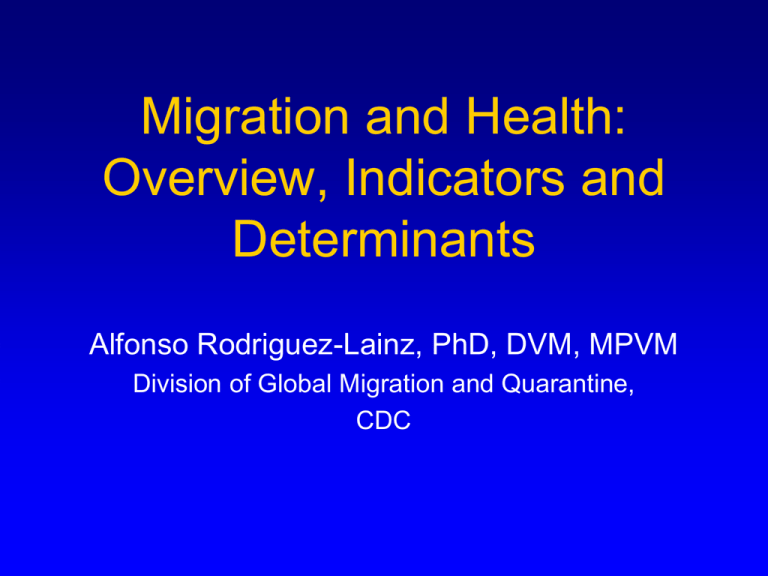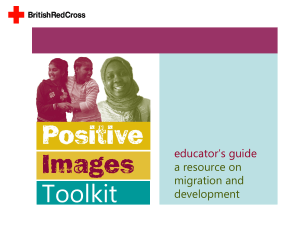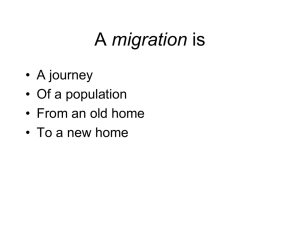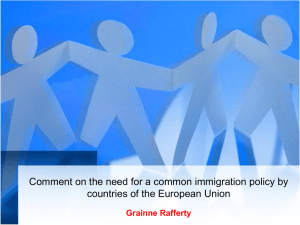
Migration and Health:
Overview, Indicators and
Determinants
Alfonso Rodriguez-Lainz, PhD, DVM, MPVM
Division of Global Migration and Quarantine,
CDC
Outline
• What is migration?
• Who is a migrant?
• What is migrant health?
• Determinants of migrant’s health after
resettlement
• Migrant health indicators
Migration: People on the move!
Migration: movement of people
• Across an international border
(international migration) or within a country
(internal migration)
• Different durations and patterns
– (e.g., permanent, temporary, cyclical)
• Different causes
– (e.g., economic, forced, family reunification)
Source: J. Weekers (IOM) Global Consultation on Migrant and Health, Madrid,
Spain (3–5 March 2010); adapted from IOM Glossary on Migration (2004)
Who is a migrant?
Who is a migrant?
• No universally accepted definition
• Countries and agencies use their own
criteria, based and their own legislation
and policies
• Definitions are not consistently used
• “Popular” terms
Migration-related terminology
Migrant
Immigrant
Minorities
Foreign born
Mobile
populations
What are the
international
recommendations?
International Migrant
UN Recommendations (1998 and 2007)
• A person changing his/her country of
usual residence … for at least 12 months
Residence
in new
country
Sources:
-UN Recommendations on International Migration Statistics (1998)
- UN Expert Group Meeting on the use of censuses and surveys to measure international migration,
ESA/STAT/AC.132/1 (2007)
Some statistics …
Source: WHO (2010)
International migrants as a share
of the total world population
International
migrant
3.1%
Native
residents
96.9%
Source: United Nations Population Division
Top 20 countries with the highest % of international migrants,
2010
Croatia
15.9
Gambia
16.6
Lebanon
17.8
Gabon
18.9
Kazakhstan
19.5
Ireland
19.6
Canada
21.3
Australia
21.9
New Zealand
22.4
Switzerland
U.S.A: 13.5%
UK & France: 11%
23.2
Saudi Arabia
27.8
Oman
28.4
China, Hong Kong SAR
38.8
Israel
40.4
Singapore
40.7
Occupied Palestinian Territory
Jordan
43.6
45.9
68.8
Kuwait
United Arab Emirates
70.0
Qatar
86.5
Note: Among countries
with
least30.0
1 million
0.0
10.0 at20.0
40.0 inhabitants
50.0
60.0
70.0
80.0
90.0
100.0
Source: United Nations, Department of Economic and Social Affairs, Population Division (2009).
International Migration, 2009 Wallchart (United Nations publication, Sales No. E.09.XIII.8).
International migrants:
U.S definitions
U.S Census Bureau
• Native: anyone who is a U.S. citizen at
birth. Includes:
- born in the U.S mainland or territories OR
- born abroad of at least one U.S. citizen parent
• Foreign-born: anyone who is not a U.S
citizen at birth
Source: Census Bureau, ACS
Foreign-born population,
2009
• 39.4 million
• 11.1 million
unauthorized
16
14
12
Percentage
• 12.7% of
U.S population
Foreign born as a % of the total U.S population,
1850-2008
10
8
Peak: 14.8%
(1890)
6
4
2
0
50 60 70 80 90 00 10 20 30 40 50 60 70 80 90 00 06 07 08
18 18 18 18 18 19 19 19 19 19 19 19 19 19 19 20 20 20 20
Sources: American Community Survey, 2008: Martin M & Midgley, June 2010;
and Migration Policy Institute
Top 20 countries of origin for foreign born (thousands), 2008
Other
8,945
Russia
413
Honduras
460
Poland
479
Haiti
535
Colombia
600
Jamaica
637
Germany
641
United Kingdom:
688
Guatemala
739
Dominican Republic
772
Canada
819
975
Cuba
Korea
1,031
El Salvador
1,095
Vietnam
1,138
1,361
China*
India
1,623
Philippines
1,685
China:
1,913
11,413
Mexico
0
2,000
*China excluding Hong Kong and Taiwan
4,000
6,000
8,000
10,000
Source: ACS, 2008
12,000
Hispanic Origin and Race
Source: U.S. Census Bureau, 2010 Census questionnaire
Race/ethnicity vs. Foreign-born
Percentage of foreing-born and natives among
major race/ethnic groups, U.S., 2008
100
90
32.9
80
70
%
60
50
Native
60.9
96.1
Forein-born
92.0
40
67.1
30
20
39.1
10
0
3.9
8.0
White alone,
not hispanic
Black or
African
American
alone
Hispanic or
Latino
Asian alone
Source: American Community Survey, 2008
Migration and Health
Phases of Migration
Origin country
1. Pre-departure
+Transit country
2. Journey
4. Return
Destination country
?
3. Post-arrival
Adapted from Gushulak, 2010
Migration: a bridge to global health
ORIGIN
COUNTRY
DESTINATION
COUNTRY
Disease burden
Disease burden
Health risks:
Health risks:
-
Vectors
-
Food safety
-
Sanitation
-
Others
Health beliefs/behaviors
Migration
-
Vectors
-
Food safety
-
Sanitation
-
Others
Health beliefs/behaviors
Health infrastructure
Health infrastructure
Others
Others
Prevalence gaps among countries
Migrant Health:
beyond migrants themselves
• Health issues and risks related to
migrant populations, AND the way in
which migration affects:
– Countries of origin, transit and
destination, and
– Second and later migrant generations
(Adapted from Roux, 2004; IOM)
Determinants of migrants‘
health after resettlement
The post-arrival Phase
DESTINATION COUNTRY
Disease prevalence
Individual factors
-Biology and genetics
-SES
-Health beliefs/behaviors
-Pre-existing health conditions
-Migration status
+
Health risks:
-
Vectors
Food safety
Sanitation
Others
Health beliefs/practices
Access to health care
Work opportunities
Housing
Many others (eg., language)
Individual factors
Migrants vs. U.S-born
• Genetic predispositions
• Natural or acquired immunity
• Younger age distribution
– Exception: European
• Different gender distribution
Individual factors (Cont.)
Migrants vs. U.S-born
• Lower education
– Exceptions: Africans, Europeans, Asians
• Higher poverty rates
– Exceptions: Asians, Europeans
• Limited language proficiency
– Exceptions: English-speaking countries
Individual factors (Cont.)
Migrants vs. U.S-born
• Health beliefs/behaviors
• Pre-existent health conditions
– Health conditions prevalent in home country
or acquired during transit
• Migration (legal) status
Social determinants of health
• Social/political environment
– (Anti-immigrant) Policies and regulations
– Discrimination => xenophobia
• Poor housing
• Occupation
– High-risk and low-paid jobs
Access to health care:
Vulnerabilities
• Different health systems and practices
• Legal limitations on access to care
• Other barriers:
– Culture, language, cost
– Limited awareness about available services
– Lack of health insurance
• Disparities in quality of care
Migrant health: a double jeopardy
Vulnerable minorities
• Low SES
– Income
– Housing
– Occupation
• Culture
• Discrimination
• Others
Migration-specific factors
• Limited legal rights
• Language
• Multinational exposures
(origin, transit, destination)
• Others
Access to
health
care
HEALTH
INEQUITIES
Migrant health:
a complex picture
•
The health of migrants varies across
space, time, age, gender, across
different countries of origin and type of
migration
•
Caution about making generalizations
about the health of all migrants
Mladovsky, 2005; Ingleby 2009
Migrant Health Indicators
The state of
migrant health research
• “… still in its infancy” (Ingleby, 2009)
• “The information is voluminous, but
sparse for many issues and sometimes
contradictory” (Cunningham, 2008)
Migration and Health
Research challenges
1. Limitations of available data
–
–
–
No migration-related data
Small sample sizes
Linguistic & culturally inappropriate data collection
methodologies and instruments
2. Characteristics of migrant populations
–
–
–
–
Diversity
Mobility
Rarity
Hidden
Broad migrant health patterns
• Positive health indicators
• Negative health indicators
• Worsening of health with longer residence
in the U.S
Positive health indicators:
New immigrants’ health capital
• Especially for recently arrived
immigrants
– Even after adjusting for age and other
variables
• “Healthy migrant paradox”
Positive health indicators
for migrants vs. native population
• Lower mortality rate
• Higher life expectancy
• Lower incidence and mortality due to some
cancers (e.g, breast, colon and prostate cancer)
• Perinatal health outcomes (e.g,, low birth weight)
• Less tobacco use and substance abuse
• Lower prevalence of CVD and obesity
Cunningham S.A et al. Health of foreign-born people in the
United States: a review. Health & Place. 2008
Infant mortality rates, by mother’s place of
birth and race/ethnicity of mother, U.S, 2006
Source: Mathews TJ, et al. Infant mortality statistics from the 2006 period linked birth/infant death data set.
National vital statistics reports; vol 57 no 2. Hyattsville, MD: National Center for Health Statistics. 2010
Past month tobacco use,
U.S. born Past
vs. foreign
born by gender,
month
1999-2001
45
40
39.7
Percentage
35
27.8
30
26.7
25
20
13.4
15
10
5
0
U.S born
Foreign born
Male
U.S born
Foreign born
Female
Source: SAMHSA, Office of Applied Studies, National Survey on Drug Use and Health, 1999-2001
Negative health indicators
for migrants vs. native population
•
•
•
•
•
•
Access to care and quality of care
Preventive health services
Immunization coverage (especially adults)
Lower health literacy
Infectious diseases (eg., TB, hepatitis B, HIV/AIDS)
Higher incidence and mortality due to some cancers
(eg., cervical, liver)
• Occupational, transportation and home injuries
Health insurance coverage of non-elderly,
by citizenship status, 2008
100%
90%
80%
70%
60%
50%
40%
30%
20%
10%
0%
15
18
67
22
11
46
Uninsured
13
Medicaid/other
public
Private
67
41
Native citizens
Naturalized
citizens
Non-citizens
Current Population Survey March Supplement, 2009
Source: Kaiser Family Foundation Immigrants’ Health Coverage and Health Reform: Key Questions and Answers (December, 2009)
Source: 2007 California Health Interview Survey
Percentage of women 30 years and older
with a mammogram within previous 2 yrs,
California, 2007
Source: 2007 California Health Interview Survey
Particularly vulnerable migrants
•
•
•
•
•
•
Victims of human trafficking
Refugees and asylum seekers
Unauthorized migrants
Labor migrants in high risk occupations
Indigenous
Detained and deported migrants
Worsening of Health
With Longer Residence
Diabetes prevalence* for foreign-born
(by length or residence) vs. U.S-born
*Adjusted for age, sex, poverty, income ratio, BMI, smoking status, alcohol
drinking status, marital status, survey year, region of birth migrants)
Source: Oza-Frank et al. Diabetes prevalence by length of residence among U.S immigrants. J Imm Minority Health (2009)
Thank you! Gracias!
Alfonso Rodriguez-Lainz
jqi3@cdc.gov
References
•
Gushulak BD, Weekers J, MacPherson DW. Migrants in a globalized world – health threats risks
and challenges: an evidence-based framework. Emerging Health threats Journal 2009, 2:e10
http://www.eht-forum.org/ehtj/journal/v2/pdf/ehtj09010a.pdf
•
Davis AA, Basten A, Frattini C. Migration: A Social Determinant of the Health of Migrants.
International Organization of Migration, 2009 http://www.migrant-healtheurope.org/files/FINAL%20DRAFT%20IOM.pdf
•
International Migration, Health and Human Rights. WHO, 2003
http://www.who.int/hhr/activities/en/intl_migration_hhr.pdf
•
Kandula NR, et al. Assuring the health of immigrants: what the leading health indicators tell us.
Annual review of public health. 2004;25:357-76.
•
Gushulak BD and MacPherson DW. The basic principles of migration health: Population mobility
and gaps in disease prevalence. Emerg Themes Epidemiol. 2006; 3: 3
•
IOM, Seminar on Health and Migration, Geneva 2004
http://www.iom.int/en/know/idm/smh_200406.shtml
•
Migration and health: a review of the international literature (2003), Available at: http://www.msocmrc.gla.ac.uk/ Publications/pub/PDFs/Occasional-Papers/OP012.pdf
•
McPherson DW, Gushulack BD, Mcdonald L. 2007. Health and foreign policy: influences of
migration and population mobility. Bullletin of the World Health Organization, 85(3):200-206
References
•
Cunningham SA. et al. Health of foreign-born people in the United
States: a review. Health Place. 2008 Dec;14(4):623-35.
•
Carballo M et al.. Migration and health in the European Union. Trop Med
Int Health. 1998 Dec;3(12):936-44.
•
Mladovsky P. Migration and Health in the EU. European Commission.
2007
•
Beiser M. The health of immigrants and refugees in Canada . Revue
Canadienne de Sante Publique, 96, Suppl. 2:S30S44. 2005
•
Ingleby, D. European Research on Migration and Health. International
Organization for Migration, Background Paper, 2009
•
WHO. Health of migrants- Report by the Secretariat. A61/12 (April, 2008)
•
WHO. Health of migrants – the way forward (2010)









